The AMD Radeon RX Vega 64 & RX Vega 56 Review: Vega Burning Bright
by Ryan Smith & Nate Oh on August 14, 2017 9:00 AM ESTPower, Temperature, & Noise
Moving on from performance metrics, we’ll touch upon power, temperature, and noise. This is also normally where we’d discuss voltages, but as Vega is a new chip on a new architecture, nothing seems to read Vega 64 and 56 correctly.
In terms of average game clockspeeds, neither card maintains its boost specification at 100% with prolonged usage. Vega 64 tends to stay closer to its boost clocks, which is in line with its additional power overhead and higher temperature target over Vega 56.
| Radeon RX Vega Average Clockspeeds | ||
| Radeon RX Vega 64 Air | Radeon RX Vega 56 | |
| Boost Clocks |
1546MHz
|
1471MHz
|
| Max Boost (DPM7) |
1630MHz
|
1590MHz
|
| Battlefield 1 |
1512MHz
|
1337MHz
|
| Ashes: Escalation |
1542MHz
|
1354MHz
|
| DOOM |
1479MHz
|
1334MHz
|
| Ghost Recon: Wildlands |
1547MHz
|
1388MHz
|
| Dawn of War III |
1526MHz
|
1335MHz
|
| Deus Ex: Mankind Divided |
1498MHz
|
1348MHz
|
| GTA V |
1557MHz
|
1404MHz
|
| F1 2016 |
1526MHz
|
1394MHz
|
| FurMark |
1230MHz
HBM2: 868MHz |
1099MHz
HBM2: 773MHz |
With games, the HBM2 clocks ramp up and stay at their highest clock state. Expectedly, the strains of FurMark cause the cards to oscillate memory clocks: between 945MHz and 800MHZ for Vega 64, and between 800MHz and 700MHz for Vega 56. On that note, HBM2 comes with an idle power state (167MHz), an improvement on Fiji's HBM1 single power state. Unfortunately, the direct power savings are a little obscured since, as we will soon see, Vega 10 is a particularly power hungry chip.
As mentioned earlier, we used the default out-of-the-box configuration for power: Balanced, with the corresponding 220W GPU power limit. And under load, Vega needs power badly.
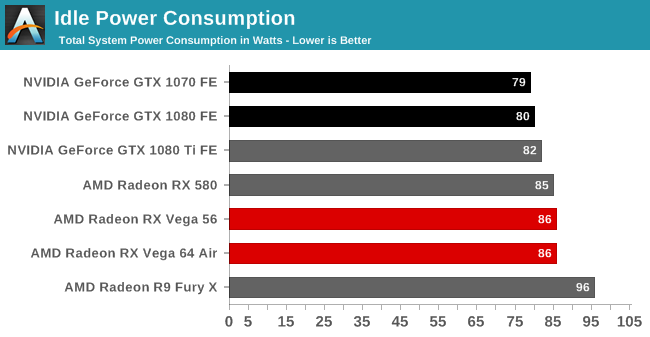
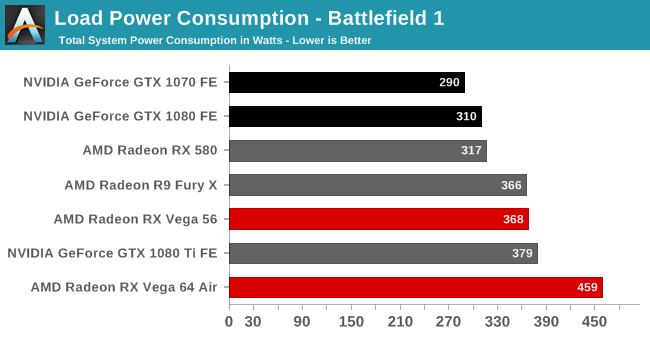
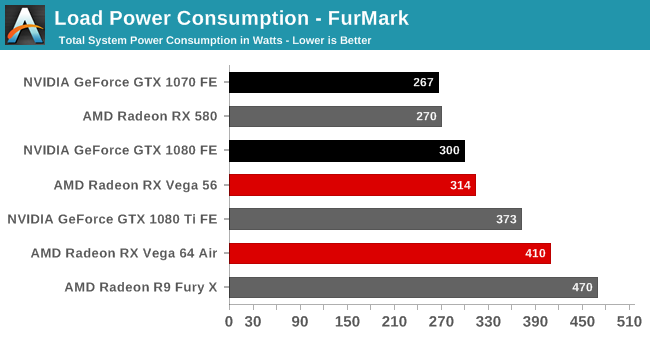
The performance of both Vega cards comes at a significant power cost. For the RX 500 series, we mused that load consumption is where AMD paid the piper. Here, the piper has taken AMD to the cleaners. In Battlefield 1, Vega 64 consumes 150W more system-wide power than the GTX 1080, its direct competitor. To be clear, additional power draw is expected, since Vega 64 is larger in both shader count (4096 vs. 2560) and die size (486mm2 vs. 314mm2) to the GTX 1080. But in that sense, when compared with the 1080 Ti, powered by the 471mm2 GP102, Vega 64 still consumes more power.
As for Vega 64's cut-down sibling, Vega 56's lower temperature target, lower clocks, and lower board power make its consumption look much more reasonable, although it is still well above the 1070.
In any case, the cooling solutions are able to do the job without severe effects on temperature and noise. As far as blowers go, RX Vega 64 and 56 are comparable to the 1080 Ti FE blower.
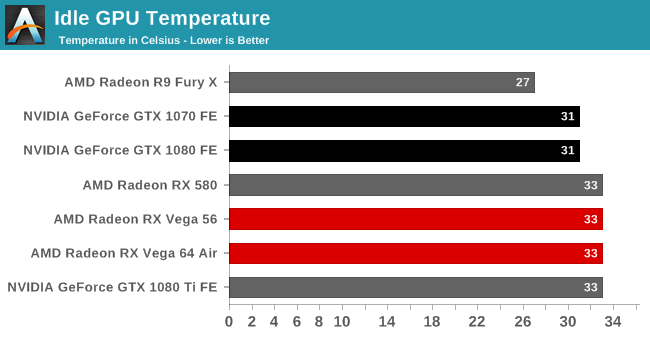
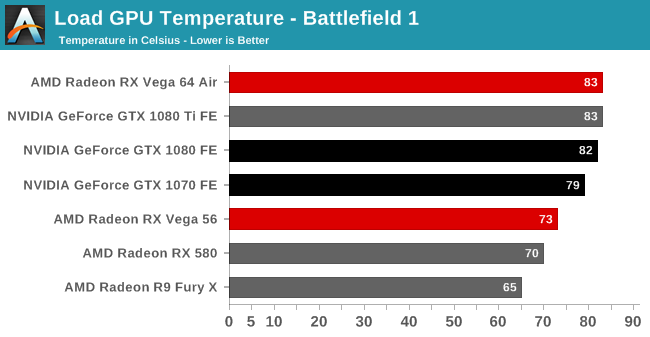

Not Graphed: Temperature of the actual Vega (Star): 9329C
Noise-testing equipment and methodology differ from past results, with a more sensitive noise meter and closer distance to the graphics card. Readings were also taken with an open case. As such, the noise levels may appear higher than expected.

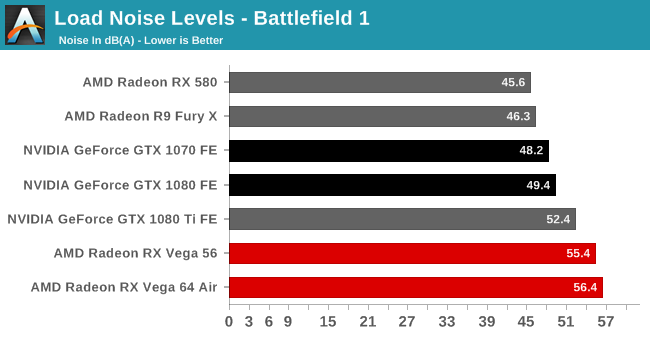
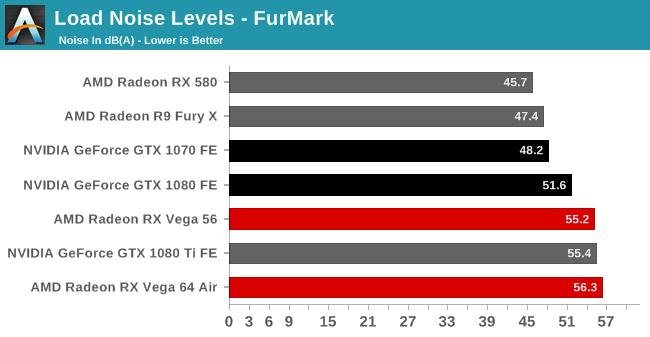










213 Comments
View All Comments
Oxford Guy - Monday, August 14, 2017 - link
This may be more of a shortcoming in the GloFo process than in the design of the chip. It would be very interesting to see how well it would do in PPW on TSMC's process.Exodite - Wednesday, August 16, 2017 - link
Of course, I were talking about the noise. :)The power consumption is, as I mentioned, a disappointment.
I'd be interested in seeing how the cards do with undervolting and other tweaks, the 480 actually gained performance in some situations due to the lower power draw resulting in more headroom.
Oxford Guy - Monday, August 14, 2017 - link
A vapor chamber is hardly "terrible" in terms of quality. But a high power draw + a blower = physics of noise.Oxford Guy - Monday, August 14, 2017 - link
Also, if one wants to talk about terrible stock cooling one should never forget the GTX 480.mapesdhs - Monday, August 14, 2017 - link
If one is in the UK, that would be a strange thing to do given it costs more than a 1080 Ti. It's priced 100 UKP higher than aftermarket 1080s with a 1759MHz base. Doesn't make sense. Factor in the power/noise, bit of a meh. If one is in the US where the price really is $500 (in the UK it's the equivalent of $750), well then maybe it's a bit more down to (irrational) brand loyalty, but still the power/noise issue doesn't make it an attractive buy IMO.The Vega56 looks far more interesting re price/performance and indeed performance, though it still has some power/noise issues. Perhaps aftermarket cooled versions will improve both cards, at least on the noise front.
mapesdhs - Monday, August 14, 2017 - link
Rats, that was supposed to be a reply to IchiOni. Why can't we edit??xfrgtr - Tuesday, August 15, 2017 - link
You'd have to be a hard core AMD fan to buy this over a GTX 1080Glock24 - Tuesday, August 15, 2017 - link
Also people that care about heat and noise care about power consumption.FourEyedGeek - Tuesday, August 22, 2017 - link
Only poor people buy AMD Vega 64, buy 1080 Ti for better performance.tipoo - Monday, August 14, 2017 - link
64 vs the 1080, yes.56 vs the 1070 is much more appealing, 100 dollars less for the same performance, plus a discount on Freesync monitors.